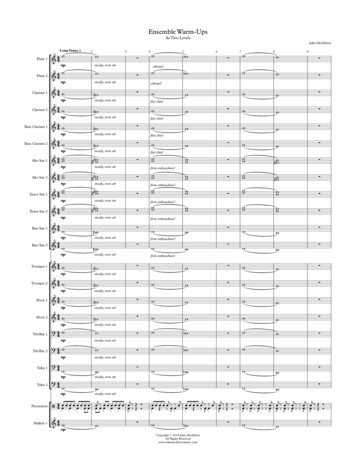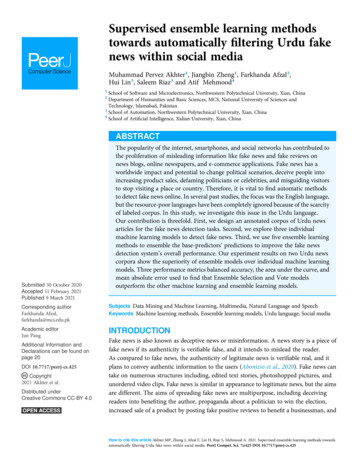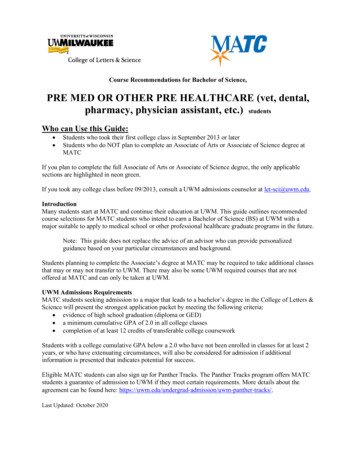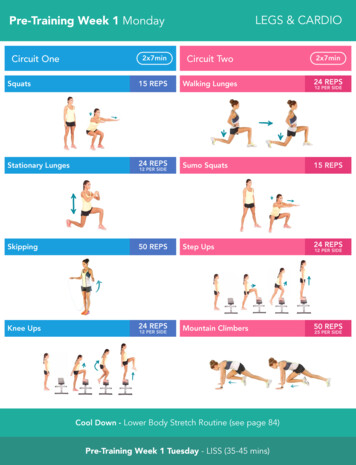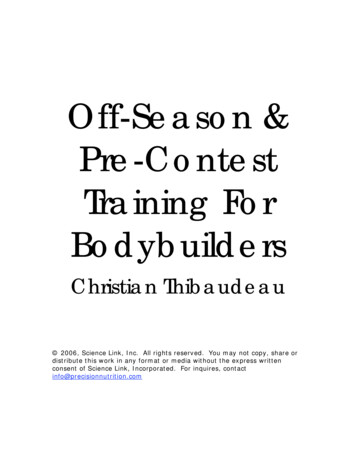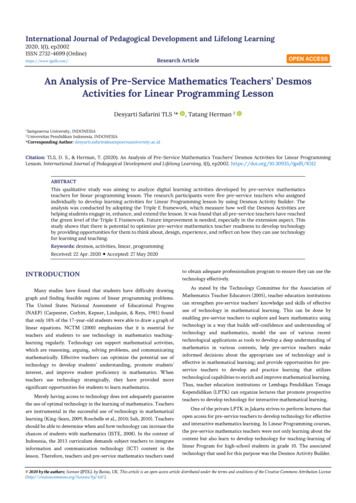
Transcription
PMap: Ensemble Pre-training Models forProduct MatchingNatthawut Kertkeidkachorn1 and Ryutaro Ichise2,11National Institute of Advanced Industrial Science and Technology,Tokyo 135-0064, Japan2National Institute of Informatics, Tokyo 101-8430, Japann.kertkeidkachorn@aist.go.jp, ichise@nii.ac.jpAbstract. Mining the Web of HTML-embedded Product Data (MWPD)Challenge aims to benchmark methods dealing with two e-commerce dataintegration tasks: 1 ) Product Matching and 2) Product Classification.In this paper, we present the design of our system, namely PMap, forthe MWPD Challenge on the Product Matching task. PMap aggregatesthe results of the various state of the art pretraining models to resolvethe identical products. Results on MWHPD show that PMap outperforms the baseline and obtains the promising performance for the product matching task. The code and the system’s outputs are available.31IntroductionDue to the growth of online shops in the e-commerce domain, semantic annotation plays a key role in enhancing the accessibility and visibility of products. Annotating the products with the semantic markup language helps a search engineto retrieve the product as a user’s expectation. However, annotated products suffer from inconsistent and heterogeneous problems from cross-sector e-commercevendors. As a result, it even leads to a situation where the product’s information is conflicted. Furthermore, without a clear benchmark, it is hard to judgethe progress of the methods in this field. To address these challenges, Miningthe Web of HTML-embedded Product Data (MWPD) challenge4 is introduced.The goal of the MWPD challenge is to provide the benchmark for the methodsdealing with two fundamental tasks in e-commerce data integration: 1) ProductMatching and 2) Product Classification.In this study, we focus on the Product Matching task. Product Matching is tomatch the same products from different websites that refer to the same real-worldproduct. To deal with the Product Matching task, we introduce the ensemblepre-train models, namely PMap. PMap takes the advantages of contextualizedembedding pre-train models together with the aggregating strategy in order touncover the identical products.34Copyright c 2020 for this paper by its authors. Use permitted under Creative Commons License Attribution 4.0 International (CC BY school-uos.github.io/mwpd/
2N. Kertkeidkachorn et al.Fig. 1. The samples of the product offers from the MWPD challenge on the productmatching tasks [1].The rest of the paper is organized as follows. We describe the problem settingof the product matching on the MWPD challenge in Section 2. Section 3 reportsthe design of our approach. In Section 4, the experimental setup details and theexperimental results are presented. We then survey the related work in Section5. In Section 6, we conclude our work.2Problem SettingA product offer is a collection of textual attributes that describes the real-worldproduct. Generally, product offers are published as the product descriptions withspecification tables, i.e. HTML tables that describe specifications about the offersuch as price or brand of the product. The samples of the product offers arepresented in Figure 1.Product Matching in the MWPD challenge is the task to classify whether thegiven two product offers are identical, i.e. two product offers refer to the samereal-world object. We can formulate the Product Matching problem as follows:Let D and D0 be two collections of product offers from different resources.We assume that product offers in D and D0 have the same schema, i.e. a productoffer is described by the same set of attributes A. Given D {PD1 , PD2 , PD3 ,., PDn } and D0 {PD10 , PD20 , PD30 , ., PDn0 }, where PDi is the i th productoffer of D and PDi0 is the i th product offer of D0 , the objective of the productmatching is to model the function f : (PDi , PDi0 ) {0, 1}. If two products referto the same object, the function f (·) returns 1, otherwise 0.For example, in Figure 1, the product offer a and the product offer c arefrom D and the product offer b and the product offer d are from D0 . The pairs
PMap: Ensemble Pre-training Models for Product Matching3Fig. 2. The design pipeline of PMapof product offers (a, b) and (c, d) are given. The pair of product offers (a, b)is the match pair (f : (a, b) 1), while the pair of product offers (c, d) is thenon-match pair (f : (c, d) 0 ).3ApproachWe design our system (PMap) as the 3-steps pipeline. As shown in Figure 2, ourpipeline consists of 1) Pre-processing, 2) Fine-tuning Pre-train Models, and 3)Ensemble Models. The details of each step are as follows.3.1Pre-processingIn the MWPD challenge, WDC Product Data Corpus5 is used as the dataset. Itis derived from the Web Data Commons6 extracted by using schema.org annotations from the Common Crawl7 . Although some cleaning pre-processing stepsare taken into account on the dataset [6], we found that it is still necessaryto further pre-process the dataset due to the character encoding and symbolin the data. To pre-process the dataset, we remove symbols and non-alphabetcharacters by using a simple regular expression.3.2Fine-tuning Pre-train ModelsFine-tuning Pre-train Models is the core step of PMap. In this section, we explainthe pre-train models and how to fine-tune uctureddata/https://commoncrawl.org
4N. Kertkeidkachorn et al.Fig. 3. Illustration of the fine-tuning pre-train models for the product matching task.Pre-train Models, also known pre-trained language representation models,widely gain attention in the NLP community due to their transfer learning ability. Such pre-train models can easily achieve state-of-the-art performances forvarious NLP standard tasks [8] by simply fine-tuning the models over specifictasks. One of the state-of-the-art pre-train contextual language representationmodels is BERT [2]. It builds upon a multi-layer bidirectional Transformer encoder, which is based on the self-attention mechanism. During the pre-trainingrepresentation learning, BERT is trained on large-scale unlabeled general domain corpus from BooksCorpus and English Wikipedia in order to perform themasked language task and the next sentence prediction task. Based on the success of the BERT, various pre-train models have also been introduced such asDistilBert[7] and Roberta[5]. We can build various models for product matchingby fine-tuning pre-train models.Fine-tuning is to optimize the model for the specific task. The architecture forfine-tuning pre-train models for the product matching task is shown in Figure3. Given the input pair (PDi , PDi0 ), the first token of every sequence of inputpairs is always a special classification token [CLS]. Following [CLS], the productoffer PDii is represented as the sequence of tokens containing the title of thePDPDPDPDproduct offer PDi T1 i , T2 i , T3 i , . , Tn i , where n is the length for PDi0of titles after tokenized. Then, [SEP] is put after the sequence representation ofPDi . After [SEP], the product offer PDi0 is represented by the similar way of theproduct offer PDi as the sequence of tokens containing the title of the productPD0offer PDi0 T1iPD 0, T2iPD0, T3iPD 0, . , Tm i , where m is the length of titles for
PMap: Ensemble Pre-training Models for Product Matching5PDi0 . Note that, at first, we aim to treat the product offer as the documents anduse the whole details of the product offer as the sequence of tokens. However,the pre-train model allows the sequence of the tokens with the maximum lengthat 512. To fit the pre-train model within this limitation, we decide to use theonly title as a representation of the product offer. As a result, it is still room toinvestigate the other attributes of product offers as features.After feeding the input sequences to the pre-train model, the final vector representation C corresponding to [CLS] is used as the representation of the inputsequence to pass to the shallow neural network for building the classifier. Wecompute a cross-entropy loss with the following equations to train the classifierXL ŷ σ(CW T )(1)y · log(ŷ0 ) (1 y) · log(ŷ1 )(2)(PDii ,PD0 )i, where σ(·) is the sigmoid function, W is the classification layer weight ofthe shallow neural network for fine-tuning ( W IR2 C ), ŷ is a 2-dimensionalreal vector with ŷ0 , ŷ1 [0, 1], ŷ0 ŷ1 1 and y is the label for the pair of input(y 0, 1).3.3Ensemble ModelsBased on the preliminary results on the validation dataset, we found most ofthe pre-train models achieved very remarkable performance. However, when weobserved and analyzed the result on each sample in the training process, it turnedout that each pre-train model could capture different aspects of the data. Forexample, we found that RoBERTa could capture the typo error, whereas otherscould not. Due to this signal, PMap combines the results from various pre-trainmodes to capture various types of aspects of the dataset and make the finalprediction with these results.4Experiments and ResultsIn this section, we report the experiments of PMap on the product matchingtask of the MWPD challenge.4.1Experimental SetupThe experimental setup is as follows:Datasets. The Product Matching dataset is derived from the WDC Product Data Corpus and Gold Standard for Large-Scale Product Matching. Theproduct data corpus contains 16M product offers. In the product matching task,there are 68,461, 1,100, and 1,500 offer pairs for training, validating, and testingrespectively.
6N. Kertkeidkachorn et al.Table 1. The Result on the Product Matching TaskSystemBaseline [6]distilbert-base-uncased bert-base-uncased bert-large-uncased roberta-base roberta-large .8204Recall F1 (positive pairs 2090.87250.84590.86910.85820.90480.8605Settings. We select various pre-train models including distilbert-base-uncased,bert-base-uncased, bert-large-uncased, roberta-base, and roberta-large. The pretrain models are available at the huggingface repository8 . To implement themodel as in Figure 3, we employ the implementation of AutoModelForSequenceClassification9 . We set the hyper-parameters in the fine-tuning process as follows: batch: 8, 16 or 32 (depending on the largest batch that can be loaded tothe memory), learning rate: 2e 5, epochs: 2-4, dropout rate: 0.1. The maximum length of tokens is set at 150 due to the length of the titles in the dataset.During the testing, we select bert-large-uncased, roberta-large, and roberta-basefor the ensembling of the results in the pipeline. This selection is based on theobservation of the validation dataset.Baseline. In the product matching task, deepmatcher [6], a state-of-theart matching method is used as the baseline. Also, we additionally conduct theexperiment on each pre-train model for the ablation study of our approach.Evaluation Metrics. Precision, Recall and F1 score on the positive class(class 1) is calculated.4.2ResultsTable 1 reports the results of PMap for the product matching task. The bestprecision is obtained from the Roberta-large model, while PMap gives the best recall. Overall, PMap outperforms the baseline in F1 score and obtains the promising performance for the product matching task.5Related WorkProduct Matching is a special case of the entity linking, which considers the disambiguation of a real-world entity in the e-commerce domain. There are face.co/transformers/model doc/auto.html We additionally evaluate these results after releasing of the ground truth for thetest dataset.
PMap: Ensemble Pre-training Models for Product Matching7research works related to entity linking [3, 4, 6]. Early works focused on modeling the approaches with rule-based and statistics-based methods [3]. Later,the machine learning-based approach has become a popular approach due toits strong performance [4]. In recent years, the deep learning-based approach isextremely successful in many application domains. Deepmacther[6], one of thedeep learning approaches, models the deep neural network and achieves the stateof the art for the product matching task. However, we notice that the pre-trainmodels have not been gained much attention in the product matching task yet.The pre-train models (e.g. BERT [2]) achieve remarkable results on many NLPtasks. Therefore, it is worthwhile to explore the pre-train models for the productmatching task.6ConclusionIn this paper, we report the product matching system, namely PMap. PMaptakes the advantages of the pre-train models to build the classifiers and thenensemble the result to make the final prediction. By fine-tuning the pre-trainmodel on the language representation model. we could achieve a better resultthan the baseline. In the future, we plan to investigate the other details of theproduct such as description, price, etc. that are left unprocessed and not used inthe current system. Also, we plan to validate the results on the various pre-trainmodels because a new model comes out continuously.References1. Mining the Web of HTML-embedded Product Data. https://ir-ischooluos.github.io/mwpd/, accessed: 2020-08-302. Devlin, J., Chang, M.W., Lee, K., Toutanova, K.: BERT: Pre-training of deep bidirectional transformers for language understanding. In: Proceedings of the 2019 Conference of NAACL-HLT. pp. 4171–4186 (2019)3. Fellegi, I.P., Sunter, A.B.: A theory for record linkage. Journal of the AmericanStatistical Association 64(328), 1183–1210 (1969)4. Köpcke, H., Thor, A., Rahm, E.: Evaluation of entity resolution approaches onreal-world match problems. Proceedings of the VLDB 3(1-2), 484–493 (2010)5. Liu, Y., Ott, M., Goyal, N., Du, J., Joshi, M., Chen, D., Levy, O., Lewis, M., Zettlemoyer, L., Stoyanov, V.: Roberta: A robustly optimized bert pretraining approach.arXiv preprint arXiv:1907.11692 (2019)6. Mudgal, S., Li, H., Rekatsinas, T., Doan, A., Park, Y., Krishnan, G., Deep, R.,Arcaute, E., Raghavendra, V.: Deep learning for entity matching: A design spaceexploration. In: Proceedings of the 2018 SIGMOD. pp. 19–34 (2018)7. Sanh, V., Debut, L., Chaumond, J., Wolf, T.: Distilbert, a distilled version of bert:smaller, faster, cheaper and lighter. arXiv preprint arXiv:1910.01108 (2019)8. Wang, A., Singh, A., Michael, J., Hill, F., Levy, O., Bowman, S.: GLUE: A multi-taskbenchmark and analysis platform for natural language understanding. In: Proceedings of the EMNLP Workshop BlackboxNLP: Analyzing and Interpreting NeuralNetworks for NLP. pp. 353–355 (2018)
integration tasks: 1 ) Product Matching and 2) Product Classi cation. . notating the products with the semantic markup language helps a search engine to retrieve the product as a user’s expectation. However, annotated products suf- . Ensemble
